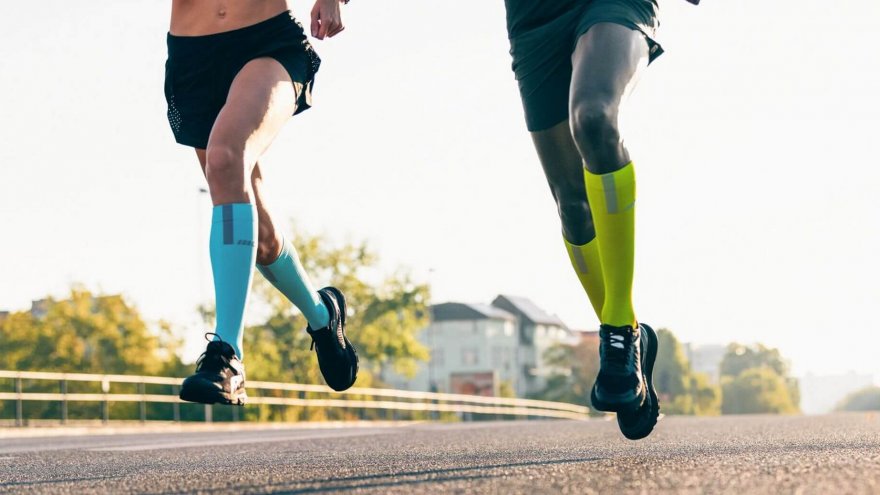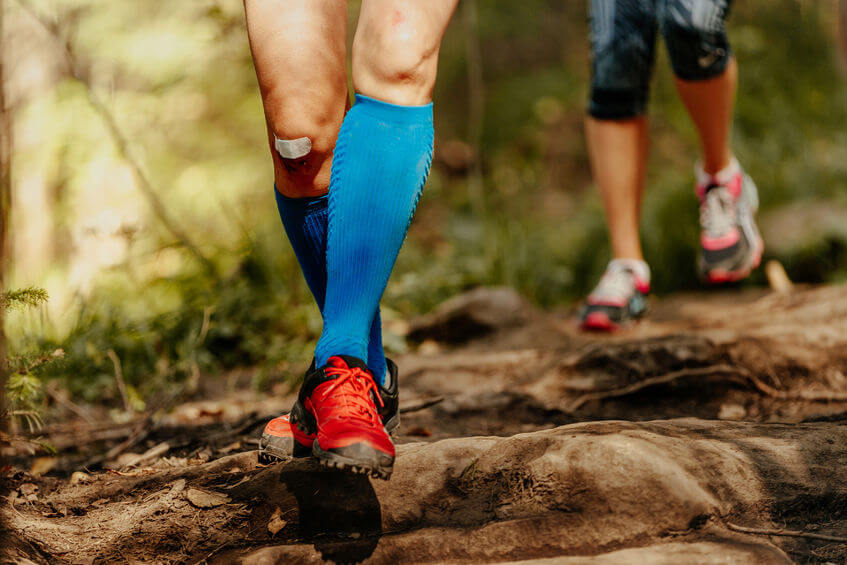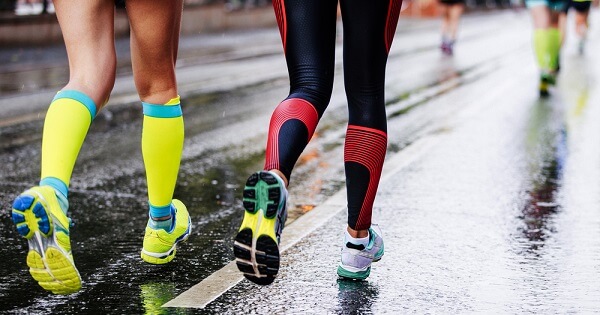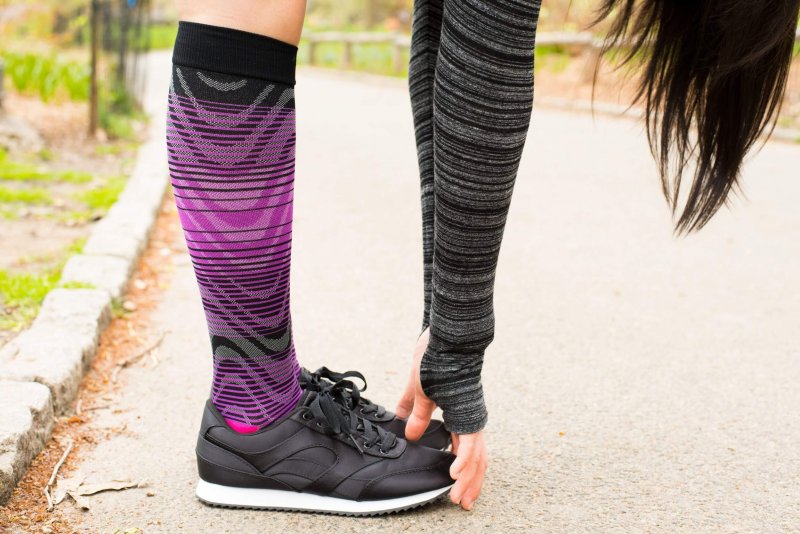Do Compression Socks Work? Benefits, Types & Care

If you are new to the distance running world, you may not know that many runners swear by wearing compression socks for running. However, there are many benefits of wearing compression on your feet and legs.
There are two ways to wear compression. They come in the form of socks and sleeves. Some people prefer compression sleeves because then you can wear your favorite running socks with them. Others like compression socks. Both achieve the desired result for runners.
What Do Compression Socks Do For Runners?
Runners swear that wearing quality compression socks helps to reduce swelling when they are worn on long runs. In addition, runners will tell you that they will help alleviate lower leg pain on long runs. Wearing compression can help you leg cramps at bay which is a huge benefit.

Die-hard compression enthusiasts will swear that religiously wearing compression for running long will aid in recovery. How does it work? They bring oxygen-rich blood to the muscles. Since blood movement is necessary for recovery, it stands to reason there will be benefits.
Some athletes also attest that wearing quality calf sleeves or socks aid in jarring and reduce stress to muscles. Since the compression apparel is quite snug-fitting, everything is neatly and conveniently held in place. This can be helpful when pounding out longer runs.,
When people wear compression socks religiously on longer runs, they often find they can run longer at a stretch without experiencing the same muscle fatigue they had before finding compression. And if something works for you, why not continue doing it?
Compression also reduces swelling. This is particularly helpful for people running in ultra races. Imagine doubling or even tripling that amount of time if you have run for a few hours training for a marathon. Anything you can do to help keep you on your feet and moving forward is a must-have!
Non-Performance Benefits Of Compression
In addition to performance gains, there are also non-performance benefits to compression. Compression socks can keep your lower legs warm while running. Helpful in winter running, it is also precious to trail runners. Suppose you are on a very primitive trail you never know when you might end up ankle-deep in water or a puddle of some sort. Compression socks tend to be knee-high which can add a warm layer.

Especially nice for trail runners, a compression sock also adds a layer of protection from things you might encounter on the trail. Again speaking to those primitive trails where you may encounter twigs, sticks, or kicked-up rocks, the thick compression socks can help keep your legs protected. Protecting your legs from small cuts or scrapes, or experiencing unwanted plants like poison ivy, is a great idea!
Compression socks also look super cool. Look round at a race, and you may notice that it seems all the cool kids are wearing flashy, bright-colored socks or sleeves. How can you resist that look?
Compression Socks For Recovery
There is increasingly more evidence that compression socks may be beneficial for recovery. Wearing compression post-workout can reduce muscle soreness and speed up your recovery process.
The jury is still out if this is a real benefit or a placebo effect, but the fact remains that people seem to feel real benefits. If wearing the compression gives you a psychological boost and helps you to run the following day again with confidence, that is a win-win.
How Long Should You Wear Compression Socks After Running?
If you are hoping to ease your discomfort, consider wearing the compression for three to four hours post-workout. It is also helpful to spend some time relaxing and with your legs elevated after the workout.
Compression Socks for Shin Splints
As a cross country and track coach, I often recommended wearing compression socks or sleeves to runners suffering from shin splints. Some coaches use pressure point taping at the point of pain, but I found that compression socks were an easy way to keep symptoms under control.
Some runners don’t wait for the shin pain to start and use compression socks for injury prevention.
How Do You Choose Compression Socks For Running?
First off, make sure the socks are knee socks. You want them to cover the entire calf. Next, they should fit perfectly. You do not want any bunching at all in compression socks. Compression socks are meant to be so snug that they are actually a bit challenging to get them on and pull them up into place.

It would be best if you chose socks with graduated compression. This means they are very snug around the ankle and slowly become less tight as they work their way up. Most people prefer a mid-range level of compression. However, people do have different preferences.
Lastly, be sure the socks you wear are moisture-wicking. If they are made for athletes, they should be. Just check the fabric components!
Getting the Right Fit
Chosen by your calf size, not shoe size, compression socks should be chosen carefully to ensure they are neither too tight nor too loose. You should also check for seams in the socks. The last thing you want is many uncomfortable seams hitting your feet in a place that will cause blisters and/or discomfort.
The padding should hit your foot at the right spots. Also, the heel should angle properly for your feet.
Washing Your Compression Socks
You should read the packaging for instructions on how to wash your compression socks. If in doubt, either hand washes or wash in your machine on a gentle cycle. Always avoid using any type of fabric softener for your workout gear, especially compression materials. For best results, your workout gear should all be hung or laid flat to dry.
Compression socks for running are not simply to be cool. There are many benefits that most runners would enjoy if they gave compression socks or sleeves a try. Remember, they can be used during runs, for post-run recovery, or just for lounging around.
Latest Articles
 Is Running on a Treadmill Easier Than Running Outside?Runners have their own preferences, whether it is treadmill running, running outside on the road, or exploring trails. So...
Is Running on a Treadmill Easier Than Running Outside?Runners have their own preferences, whether it is treadmill running, running outside on the road, or exploring trails. So... Is It OK to Use Trail Running Shoes on the Road?While trail running shoes can be used on roads, especially in situations where a runner encounters mixed terrains or pref...
Is It OK to Use Trail Running Shoes on the Road?While trail running shoes can be used on roads, especially in situations where a runner encounters mixed terrains or pref... How to Fix Sore Quads After Running?Rest, ice, gentle stretching, and over-the-counter pain relievers can help soothe sore quads after running. Also, ensure ...
How to Fix Sore Quads After Running?Rest, ice, gentle stretching, and over-the-counter pain relievers can help soothe sore quads after running. Also, ensure ... 10 Fruits With The Most Electrolytes to Replace Sports DrinksThese fruits are high in electrolytes such as potassium, magnesium, and calcium, essential for hydration, muscle function...
10 Fruits With The Most Electrolytes to Replace Sports DrinksThese fruits are high in electrolytes such as potassium, magnesium, and calcium, essential for hydration, muscle function...

